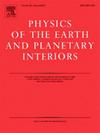探索阿尔及利亚东北部bejaya - babors剪切带(BBSZ)的结构成分:利用近期地震事件(2012 - 2022)的当地地震层析成像证据
IF 1.9
3区 地球科学
Q2 GEOCHEMISTRY & GEOPHYSICS
引用次数: 0
摘要
近年来,阿尔及利亚的Bejaia- babors (BB)地区经历了重大的地震活动,包括2012-2013年的Bejaia- babors地震序列、2019年的Jijel地震、2020年的El Aouana地震以及随后在2021年和2022年发生的Bejaia地震。这些地震事件不仅揭示了bejaya - babors剪切带(BBSZ)的存在,而且强调了识别其结构成分、深度和范围的重要性。我们的研究重点是分析2012年至2022年的地震数据,特别强调阐明这种地质结构的复杂性。利用LOTOS(局部层析成像软件)算法,我们进行了三次层析成像反演,成功获得了水平和垂直剖面,有助于识别和表征地下异常。由此产生的三维速度模型揭示了BBSZ内的关键构造,包括Jijel海上断裂系统(OFSJ)、South Greater Kabylia断裂(SGKF)、1号横向断裂(TF1)以及小Kabylia地块(LKB)和Babors地块(THF-1)之间的碰撞。东部沿阿夫提斯断层(AF)发育脆性-韧性剪切带,西部沿巴伯斯横断层(BTF)发育脆性剪切带。纵波速度分析表明存在刚性块体。在BTF断层3段附近观察到的高Vp/Vs比值表明存在流体储层,可能涉及到bejaya - babors地震序列(2012 - 2013),如先前文献所述。这些发现为了解北断带的构造格局提供了有价值的见解,突出了主要断裂系统和不同构造块体之间的相互作用。沿AF的脆性-韧性剪切的存在表明该地区存在复杂的变形过程。总的来说,通过识别关键断裂系统,表征地下异常,揭示流体储层的存在,我们的研究不仅对地球动力学知识做出了重大贡献,而且对地震危险性评估,资源勘探以及该领域的未来研究具有重要意义。本文章由计算机程序翻译,如有差异,请以英文原文为准。

Exploring the structural components of the Bejaia-Babors shear zone (BBSZ) in NE Algeria: Evidence from local earthquake tomography using recent seismic events (2012−2022)
In recent years, the Algerian region of Bejaia-Babors (BB) has experienced significant seismic activity, including the Bejaia-Babors seismic sequence in 2012–2013, the Jijel earthquake in 2019, the El Aouana earthquake in 2020, and Bejaia subsequent earthquakes in 2021 and 2022. These seismic events have not only brought to light the existence of the Bejaia-Babors Shear Zone (BBSZ) but have also emphasized the importance of discerning its structural components, depth, and extent. Our study focuses on the analysis of seismological data from 2012 to 2022, with a particular emphasis on elucidating the intricacies of this geological structure. Using the LOTOS (local tomography software) algorithm, we conducted three iterations of tomographic inversion, successfully obtaining horizontal and vertical sections that facilitated the identification and characterization of subsurface anomalies. The resulting 3D velocity models unveiled key tectonic structures within the BBSZ, including the Offshore Faults System of Jijel (OFSJ), South Greater Kabylia Fault (SGKF), Transversal Fault 1 (TF1), and the collision between the Lesser Kabylia Block (LKB) and the Babors (THF-1). Futhermore, brittle-ductile shears were identified along the Aftis Fault (AF) in the east and brittle shears along the Babors Transverse Fault (BTF) in the west. P-wave velocity analysis indicated the presence of rigid blocks. The observed high Vp/Vs ratio near segment 3 of the BTF fault suggests the presence of a fluid reservoir, likely involved in the Bejaia-Babors seismic sequence (2012−2013), as previously documented. These findings provide valuable insights into the tectonic framework of the BBSZ, highlighting major fault systems and the interaction between different tectonic blocks. The presence of brittle-ductile shears along the AF suggests complex deformation processes in this region. Overall, by identifying key fault systems, characterizing subsurface anomalies, and unveiling the presence of fluid reservoirs, our research not only contributes significantly to geodynamic knowledge but also holds immense significance for seismic hazard assessment, resource exploration, and future research in this field.
求助全文
通过发布文献求助,成功后即可免费获取论文全文。
去求助
来源期刊

Physics of the Earth and Planetary Interiors
地学天文-地球化学与地球物理
CiteScore
5.00
自引率
4.30%
发文量
78
审稿时长
18.5 weeks
期刊介绍:
Launched in 1968 to fill the need for an international journal in the field of planetary physics, geodesy and geophysics, Physics of the Earth and Planetary Interiors has now grown to become important reading matter for all geophysicists. It is the only journal to be entirely devoted to the physical and chemical processes of planetary interiors.
Original research papers, review articles, short communications and book reviews are all published on a regular basis; and from time to time special issues of the journal are devoted to the publication of the proceedings of symposia and congresses which the editors feel will be of particular interest to the reader.
 求助内容:
求助内容: 应助结果提醒方式:
应助结果提醒方式:


